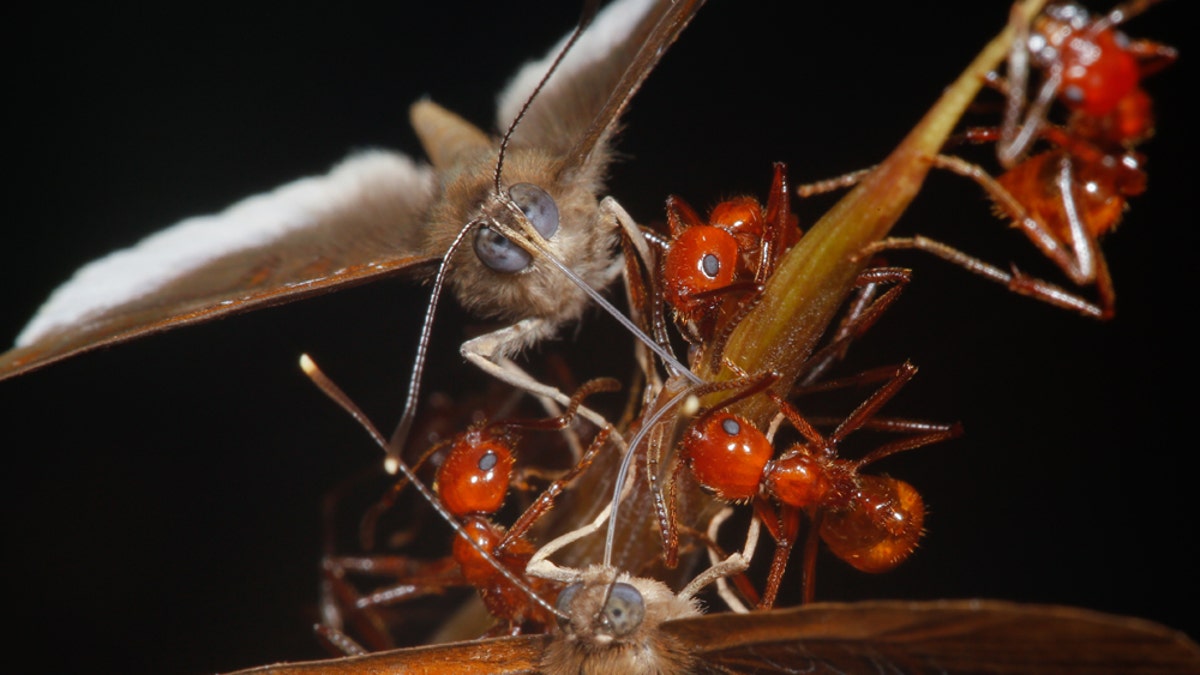
A new study has shown a strange relationship between a butterfly species and the ants it hangs out with. While the larvae and the ants provide mutual benefits to each other, the adult butterflies are freeloaders that stea (Phil Torres)
A bizarre Amazonian butterfly is the ultimate freeloader, researchers say.
The butterfly species steals and eats gooey bamboo secretions from its ant neighbors, in a relationship known as kleptoparasitism, new research has found.
"They're kind of jerks at the adult stage," said study co-author Aaron Pomerantz, a field biologist at thenextgenscientist.com. "They're just stealing a resource, and they're getting away with it for now."
Pomerantz and his colleagues have now captured images of the odd behavior — the first time that kleptoparasitism has been documented between adult butterflies and ants. [See Gorgeous Images of Butterflies Stealing Ant Goo]
Long-standing relationship
The goo-stealing butterflies, Adelotypa annulifera, are a wide-ranging species thatlives in a swath of South America from Bolivia to Guyana.
In 2013, Pomerantz's colleague Phil Torres was taking photos in the Amazon forest near the Tambopata Research Center in Peru when he noticed the butterflies feeding on bamboo sap where ants were congregating.
Torres told Pomerantz about it, and the two soon realized that although the species had been identified a century earlier, almost nothing was known about the life cycle of this butterfly.
"We had no idea what the caterpillars looked like; no one had ever seen them before," Pomerantz said.
So, upon returning to the site, Pomerantz went on a hunt to find the caterpillars of the species. He spent many weeks looking through the bamboo forest where Torres had originally found the creatures.
"Finally, I peeled back this little leaf, and that's when we saw the larvae," Pomerantz said.
As they returned over and over again to study the butterflies and ants, they noticed that the two species stuck together through all of the butterflies' life stages, from larvae to adults, the researchers reported in the June issue of the Journal of the Lepidopterists' Society.
 
Still freeloading as adults
When the relationship starts out, it seems to be more of a two-way street. Multiple ant species — even those known as bullet ants, which deliver the world's most painful sting — offer bodyguard duty while the caterpillars give the ants a nutritious "protein shake" of amino acids and sugars through a specialized body part called the tentacle nectary organ.
Caterpillars from the same family, called Riodinidae, even lure ants by singing to them with a special vibratory organ. (The caterpillar songs are too quiet for humans to hear them without specialized equipment.)
But as adults, the butterflies become freeloaders. The butterflies sport bright-red dots on their wings — a pattern that mimics stinging ants — allowing them to disguise themselves as ants and avoid predators, Pomerantz said.
"The butterflies aren't all that skittish; they just hang out in the open, and that's uncommon for a lot of butterflies," Pomerantz said.
Even worse, the butterflies physically block the ants from feeding on the bamboo sap, hoarding all the goo for themselves. Meanwhile, researchers are unsure whether the ants get anything out of the relationship.
It's not clear why the adult ants tolerate this thievery, but one possibility is that the ants simply can't figure out what's going on. Ants have poor eyesight and typically communicate with each other via chemicals such as pheromones.
"Over evolutionary time, a lot of critters have figured out how to hack their chemistry so they can hang out with them," Pomerantz said, referring to ants.
Therefore, it's possible that the caterpillars continue to release "come hither" friendly pheromones even as they mature into adults, tricking the ants into tolerance, the researchers speculated.
Original article on Live Science.
Copyright 2016 LiveScience, a Purch company. All rights reserved. This material may not be published, broadcast, rewritten or redistributed.




















